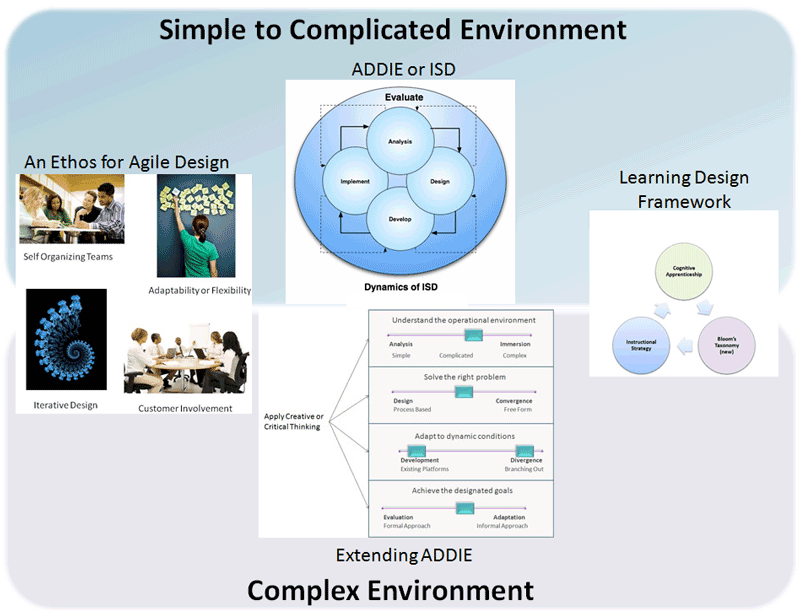Note: This site is moving to KnowledgeJump.com. Please reset your bookmark.
Instructional Design — Media, Strategies, & Methods
Media, strategies, and methods are the various tools that not only deliver the instruction, but also foster the acquisition of performance.
Media
Media is the plural of medium, which in learning and training environments, is the means of communicating and transferring a learning concept or objective to another individual. Media are the replicable “means”, forms, or vehicles by which instruction is formatted, stored, and delivered to the learner (Schwen, 1977).
There are normally two types of training media within a learning program. The first is the instructional setting or major media. For example, you might have your learners go to classroom training for 2 days or have an elearning program delivered to them. The second is the delivery systems within the major medium. These are the various instructional methods that take place within the instructional setting. In the two day class you might have several types of media, such as lectures, videos, programmed instruction, coaching, etc. Another example is an elearning platform with several types of media within it, such as videos, readings, and simulations incorporated into it.
Note that it is not unusual for a medium to carry another medium as in the above examples. McLuhan (1964) gave the example of a television (one form of media) carrying the spoken word (another form of media) of the thoughts of a person. The second medium, the spoken word, can change to best deliver the message, for example rather than speaking the person can draw, act, or write the message.

Just as people use a variety of tones, pitches, rhythm, timbre, loudness, inflections, gestures, etc. to communicate ideas to others; you should also use a variety of media to aid in the transfer of learning. This is also referred to as Blended Learning. Although no one medium is better than another, a particular medium is normally better in certain situations.
For example, showing an engine with labels naming each of the parts is probably more preferable than a long audible file explaining a car and its various parts.
The strategies and methods that will best promote the intended learning are normally selected first , and then the media that will best deliver the learning platform are selected (Clark 2001). This is because some media work better that others when it comes to delivering certain content and contexts.
However, you must know your constraints. For example, shortly after 9/11 a lot of corporations placed restrictions on travel, which meant their employees could not travel to classrooms. And during bad economic times, corporations may have to curtail their budgets, which means you have to find extremely efficient media to transport the content, such as elearning rather than classroom training. Thus it is wise to know you media constraints, so you can plan the methods accordingly.
Methods
Learning methods are the conditions which can be implemented to foster the acquisition of competence (Glaser, 1976). It helps to shape information that compensates for or supplants the cognitive process necessary for achievement or motivation (Clark, 2001).
For example, Keller's Personalized of Instruction (PSI) is normally presented in text, which is the medium. It then uses methods to structure and self-pace the lessons in order to increase the possibility of learning.
A method is normally thought of as a particular procedure for accomplishing or approaching a task. On the other hand, a strategy is more of a comprehensive plan of action designed to achieve a major goal.
Thus learning methods are normally parts of the overall strategy. For example, you use certain learning methods to teach a skill, but your strategy has to include evaluation methods to ensure the learners actually learned the skills and retention methods to ensure that the new skills do not fade away before the learners can put the new skills to productive use.
Strategies
Learning strategies determine the approach for achieving the learning objectives and are included in the pre-instructional activities, information presentation, learner activities, testing, and follow-through. The strategies are usually tied to the needs and interests of students to enhance learning and are based on many types of learning styles (Ekwensi, Moranski, & Townsend-Sweet, 2006).
Learning strategies basically encompass the entire spectrum of a learning environment, to include processes, such as media, methods, technologies, and styles.
And most importantly, strategies tie in both the learning methods and media to ensure they meet the needs of the organization's goals.
Next Steps
Listed below are some links to media, methods, and strategies examples:
Media
- Classrooms
- Distance Learning
- eLearning
- Lecture
- mLearning
- On-The-Job-Training
- Performance Aids
- Social Learning & Social Media
- Video
Methods
- Action Learning
- Boot Camp
- Coaching
- Fishbowls
- Lockstep
- Mentoring
- Personalized System of Instruction
- Programmed Learning
- 70-20-10 Learning and Training Model
Strategies
- Active Learning
- Blended Learning
- Just in Time Learning
- Learners' Framework
- Formal & Informal Learning
References
Clark, R. (2001). Learning from Media: Arguments, Analysis, and Evidence. Greenwich, Connecticut: Information Age Publishing.
Glaser, R. 1976. Components of a psychology instruction: Towards a science of design. Review of Educational Research, 46(1), 1-24.
Ekwensi, F. Moranski, J., & Townsend-Sweet, M., (2006). E-Learning Concepts and Techniques. Bloomsburg University of Pennsylvania's Department of Instructional Technology. 5.1 Instructional Strategies for Online Learning. Retrieved November 8, 2008: http://iit.bloomu.edu/Spring2006_eBook_files/ebook_spring2006.pdf
McLuhan, M. (1964). Understanding Media: The Extensions of Man. Massachusetts: First MIT Press.
Schwen, T. 1977. Professional scholarship in educational settings: Criteria for inquiring. AV Communication Reviews, 25, 35-79.



